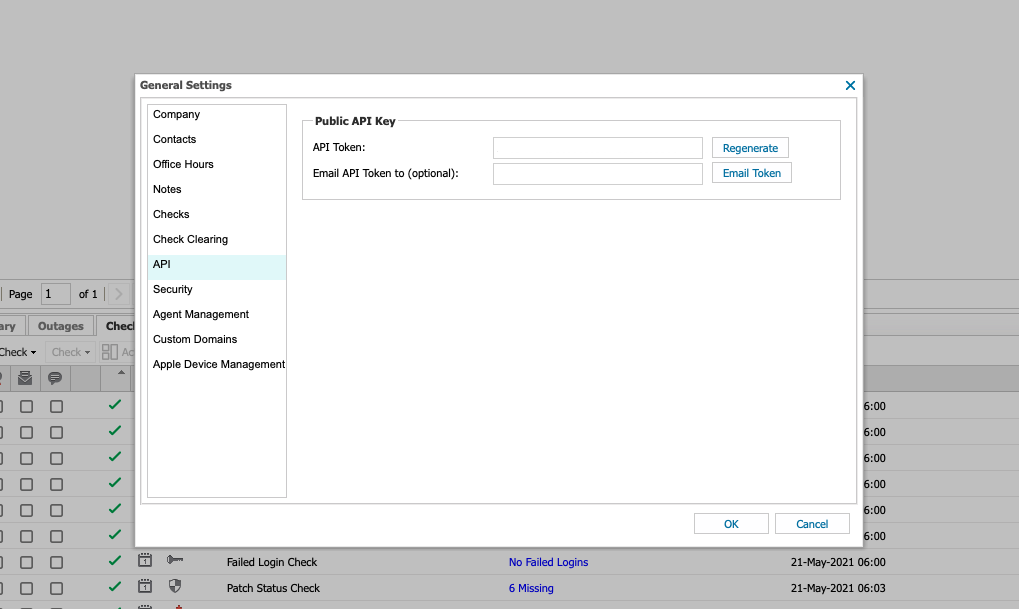N-able RMM
This document provides the steps required to configure the N-able RMM Inspector.
Quick DetailsRecommended Agent: On-Demand
Supported Agents: On-Demand or Self-Managed
Is Auto-Discovered By: N/A
Can Auto-Discover: N-able RMM Child Inspectors
Parent/Child Type Inspector: Yes
Inspection via: API
Data Summary: Here
Inspector Description
The N-able RMM Inspector is a dedicated Inspector for the N-able RMM platform.
See it in Action
Inspector Setup Preparation
To set up this Inspector, you will need the host address. You will also generate an API Access Token from your N-able RMM instance.
Liongard Inspector Setup
-
Log in to your N-able RMM Dashboard
-
Click on the Settings tab and select General Settings

- Select the API tab and click on the Generate button. If you already have an API Key generated copy the current key.
How to retrieve the Server URLIf you use the "Email API Token to" option, you will receive the Server URL via email.

Liongard Inspector Setup
Step 1: Parent Inspector Setup
Since N-able RMM is a multi-tenant system where a single portal is used to manage many Environments, you will set up a single "Parent" Inspector with your API Access Key that will then auto-discover "Child" Inspectors for each Environment.
In Liongard, navigate to Admin > Inspectors > Inspector Types > Navigate to the N-able RMM Inspector > Select Add System.
Fill in the following information:
-
Type of Inspector: Parent
-
Environment: Select your MSP's Environment
-
Friendly Name: Suggested Naming: SP Name] NN-able RMM Parent
-
Agent: On-Demand Agent
-
Inspector Version: Latest (Auto-Update)
-
Server URL: (ex: https://www.myinstance.com)
-
API Access Key: The API Access Key generated in the steps above.
-
Scheduling: The Inspector will default to run once a day at the time the Inspector is set up. Here you can adjust the schedule
Select Save. The Inspector will now be triggered to run within the minute.
Step 2: Child Inspector Setup
After the first run of the Parent Inspector, your client N-able RMM organizations will be Auto-Discovered and surfaced on the Discovered Systems page.
Navigate to the Discovered Systems tab in your Inspectors > N-able RMM page
- Activate your Discovered Systems by ensuring they're mapped to the correct Environment > Select the checkbox to the left of Inspector(s) > Select the Actions drop-down menu > Activate Launchpoints.
- Users may also Archive Discovered Systems by Selecting the checkbox to the left of the Inspector(s) > Select the Actions drop-down menu > Archive Launchpoints.
Optional: Turn on Flexible Asset/Configuration Auto-Updating
If you would like this Inspector's data to be sent to ConnectWise and/or IT Glue, turn on Flexible Assets/Configurations for this Inspector:
- ConnectWise: Admin > Integrations > ConnectWise > Configuration Types > Confirm the "Configuration Auto-Updating" toggle is enabled
- IT Glue: Admin > Integrations > IT Glue > Flexible Assets > Confirm the "Flexible Asset Auto-Updating" toggle is enabled
Payload Trimming
If your N-able RMM Child Inspectors fail due to the payload size being too large, you can edit the Inspector and choose to exclude Workstation, Antivirus, or Installed Patches details.

N-able RMM Quick Tips/FAQs
Updated 3 months ago
